If you’ve ever wondered how to cut eggplant for your favorite recipes, look no further! In this step-by-step guide, I’ll walk you through the process of cutting eggplant like a master chef.
To start, you’ll need to gather a few tools. Make sure to select the right eggplant for your recipe and have a large chef’s knife and cutting board on hand. Once you have everything ready, follow these simple steps.
Key Takeaways:
- Select the right eggplant for your recipe.
- Wash and dry the eggplant before cutting.
- Remove the ends by slicing them off at the stem and bottom.
- Slice the eggplant into rounds, long flat pieces, or cubes depending on your recipe.
- Cook the eggplant before consuming it.
By following these steps, you’ll be able to cut eggplant with ease and confidence. Stay tuned for the next sections where we’ll dive deeper into each technique and explore some popular eggplant recipes!
Selecting the Right Eggplant for Your Recipe
Before you start cutting your eggplant, it’s essential to choose the right one for your recipe. Different varieties of eggplant have distinct flavors and textures, so let’s explore some options.
Here are a few popular eggplant varieties:
- Classic Eggplant: Also known as the American or Italian eggplant, this variety is the most common and widely available. It has a deep purple skin and a rich, meaty texture, making it perfect for dishes like eggplant parmesan.
- Japanese Eggplant: These eggplants are long and slender with thin skin. They have a mild, slightly sweet flavor and a tender texture, making them great for stir-fries, grilling, or tempura.
- Globe Eggplant: This variety gets its name from its round shape. It has a slightly bitter taste and a firm, meaty texture. Globe eggplants are versatile and can be used in various dishes, such as stews, curries, or roasted vegetables.
Did you know? Eggplants are actually a fruit and belong to the nightshade family, along with tomatoes and potatoes.

| Eggplant Variety | Flavor | Texture | Best Uses |
|---|---|---|---|
| Classic Eggplant | Rich, meaty | Smooth, creamy | Eggplant parmesan, roasted vegetables |
| Japanese Eggplant | Mild, slightly sweet | Tender | Stir-fries, grilling, tempura |
| Globe Eggplant | Slightly bitter | Firm, meaty | Stews, curries, roasted vegetables |
“The choice of eggplant can greatly impact the taste and texture of your dish. Experiment with different varieties to find the perfect match for your recipe.” – Chef Sarah Anderson
When selecting eggplant, look for ones that are firm, glossy, and free from bruises or blemishes. The color should be vibrant and consistent across the skin. Avoid eggplants that feel overly soft or have wrinkled skin, as they may be overripe.
Now that you know how to choose the right eggplant variety, let’s move on to the next section to gather the tools you’ll need for cutting.
Gathering the Tools You’ll Need
Before you dive into cutting your eggplant, make sure you have the right tools on hand. A sharp chef’s knife and a sturdy cutting board are essential for smooth and precise cuts. The chef’s knife should have a long, broad blade that can easily slice through the eggplant’s flesh, while the cutting board should provide a stable surface for you to work on.
Using a dull knife or an unstable cutting board can make the process more difficult and even lead to accidents. So, it’s important to invest in quality tools that will make your experience in the kitchen more enjoyable and efficient.
Once you have your chef’s knife and cutting board ready, you’ll be well-equipped to tackle the task of cutting your eggplant with ease.
| Cutting Tools | Features |
|---|---|
| Chef’s Knife | A long, broad blade for smooth and precise cuts |
| Cutting Board | A sturdy surface for stability during the cutting process |
With these tools in hand, you’ll be ready to take on the art of cutting eggplant and unlock a world of delicious recipes. So, let’s get started on transforming this versatile vegetable into mouthwatering dishes!
Washing and Preparing the Eggplant
To ensure your eggplant is clean and ready for cutting, it’s crucial to wash and dry it properly. Here’s how to prepare your eggplant for slicing.
Step 1: Start by rinsing the eggplant under cool running water. Use your hands to gently rub off any dirt or debris on the skin.
Step 2: After rinsing, pat the eggplant dry with a clean kitchen towel or paper towel. Removing excess moisture will help prevent the eggplant from becoming soggy when cooked.
Step 3: Once dry, trim off the stem and bottom of the eggplant using a sharp knife. This will make it easier to handle and ensure a uniform shape when cutting.
Step 4: If desired, you can peel the skin off the eggplant using a vegetable peeler or a knife. This is a matter of personal preference and depends on the recipe you are following. Some dishes, like eggplant parmesan, may require the skin to be removed for a smoother texture.
Remember, always follow the recipe instructions when it comes to preparing your eggplant. Now that your eggplant is washed and ready, you can move on to the next step of cutting it into your desired shape and size.

Before you start cutting your eggplant into various shapes, it’s necessary to remove the ends. Follow these simple steps to trim off the stem and bottom.
- Begin by placing your eggplant on a clean cutting board. Make sure it is stable and won’t roll around.
- With a large chef’s knife, carefully slice off the stem end of the eggplant, removing about half an inch. Discard the trimmed end.
- Next, flip the eggplant and slice off the bottom end in the same manner, removing any remaining stem or tough parts.
- Now, your eggplant is ready to be sliced, diced, or cut into your desired shape for your recipe!

Expert tip:
It’s important to remove the ends of your eggplant before cutting to ensure even, clean slices. By trimming off the stem and bottom, you create a stable base for further cutting and remove any potential tough or bitter parts.
Now that you have removed the ends of your eggplant, you can move on to the next step in preparing your delicious dish. Whether you’re slicing it into rounds, long flat pieces, or cubes, having a properly trimmed eggplant will make the cutting process easier and yield more consistent results.
| Cutting Method | Description |
|---|---|
| Slicing into Rounds | Lay the eggplant on its side and slice it crosswise into 1-inch-thick rounds. This cutting method is perfect for grilling, roasting, or using in stir-fries. |
| Cutting into Long, Flat Pieces | Lay the eggplant on its side and slice it lengthwise into 1-inch-thick ovals. These flat pieces are great for layering in casseroles or using in recipes like eggplant parmesan. |
| Slicing into Cubes | Lay the eggplant on its side and slice it lengthwise into long, thin strips. Then, lay each strip flat and slice it lengthwise again to create small cubes. This method is ideal for recipes like baba ganoush or ratatouille. |
Slicing the Eggplant into Rounds
If your recipe calls for round slices of eggplant, here’s how you can achieve perfect, uniform rounds every time. Start by gathering the necessary tools – a large chef’s knife and a cutting board. Make sure to select a ripe eggplant that is firm and shiny, with smooth skin and no soft spots.
Next, wash and dry the eggplant to remove any dirt or residue. Then, place the eggplant on its side on the cutting board. Take the chef’s knife and slice the eggplant crosswise into 1-inch-thick rounds. To maintain even thickness throughout, use a slow, steady motion and apply gentle pressure.
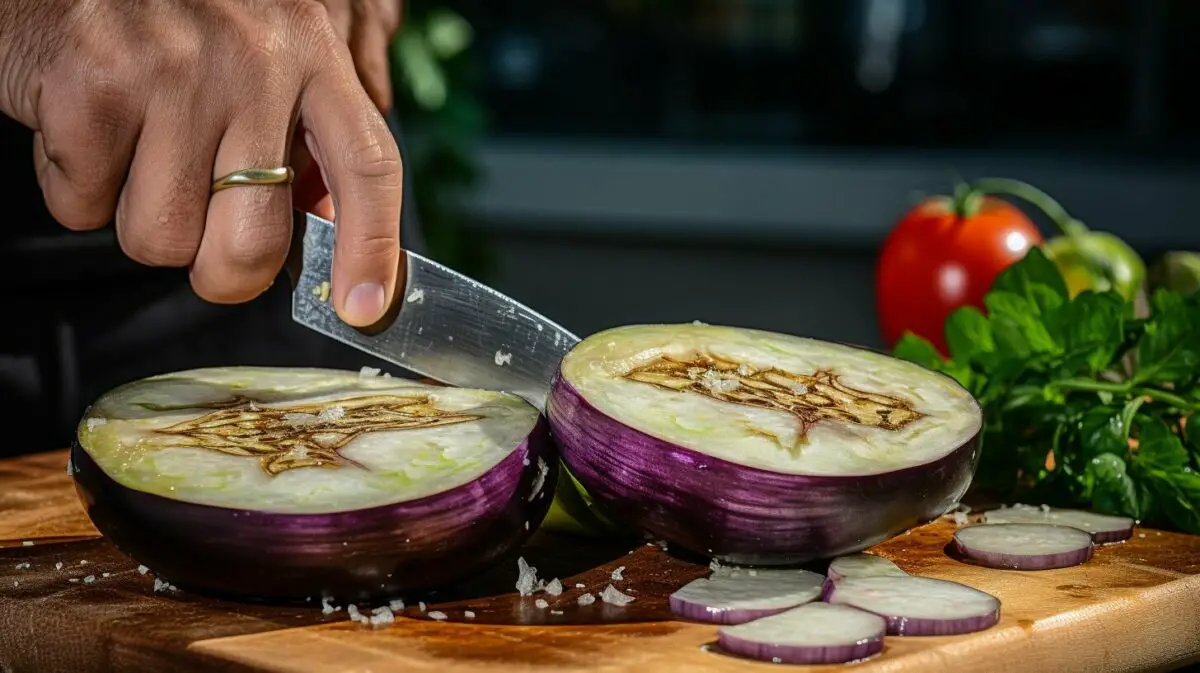
Once you have sliced all the rounds, they are ready to be used in your recipe. Whether you’re making eggplant parmesan or grilled eggplant, these uniform rounds will cook evenly and create a delicious dish. Enjoy!
Summary:
To slice the eggplant into rounds, gather a large chef’s knife and cutting board. Wash and dry the eggplant, then lay it on its side on the cutting board. Using the chef’s knife, slice the eggplant crosswise into 1-inch-thick rounds. These rounds can be used in various recipes, such as eggplant parmesan or grilled eggplant.
Cutting the Eggplant into Long, Flat Pieces
For recipes that require long, flat pieces of eggplant, follow these steps to achieve beautifully layered ovals.
1. Start by selecting a fresh eggplant that is firm and free from blemishes. Wash the eggplant thoroughly under running water and pat it dry with a clean kitchen towel.
2. Place the eggplant on a cutting board and hold it steady with one hand. Using a large chef’s knife, carefully slice off the stem and the bottom of the eggplant.
3. Once the ends are removed, lay the eggplant on its side and make a lengthwise cut along its body, about 1 inch from the edge. Continue slicing the eggplant lengthwise into 1-inch-thick ovals. Repeat this process until you have cut the entire eggplant into evenly sized pieces suitable for layering in your dish.
4. To achieve perfectly flat pieces, you can use a mandoline slicer or a sharp knife to trim any uneven edges. This will ensure that your eggplant slices lay smoothly in your casserole or lasagna.
| Benefits of Cutting the Eggplant into Long, Flat Pieces |
|---|
| Creates uniform pieces for even cooking |
| Allows for beautiful layering in dishes like eggplant Parmesan |
| Enhances presentation and texture |
Now that you know how to cut the eggplant into long, flat pieces, you can confidently tackle recipes that call for this preparation. Whether you’re making a classic eggplant Parmesan or a flavorful Mediterranean dish, your beautifully layered ovals will not only look impressive but also cook evenly for a delicious result.
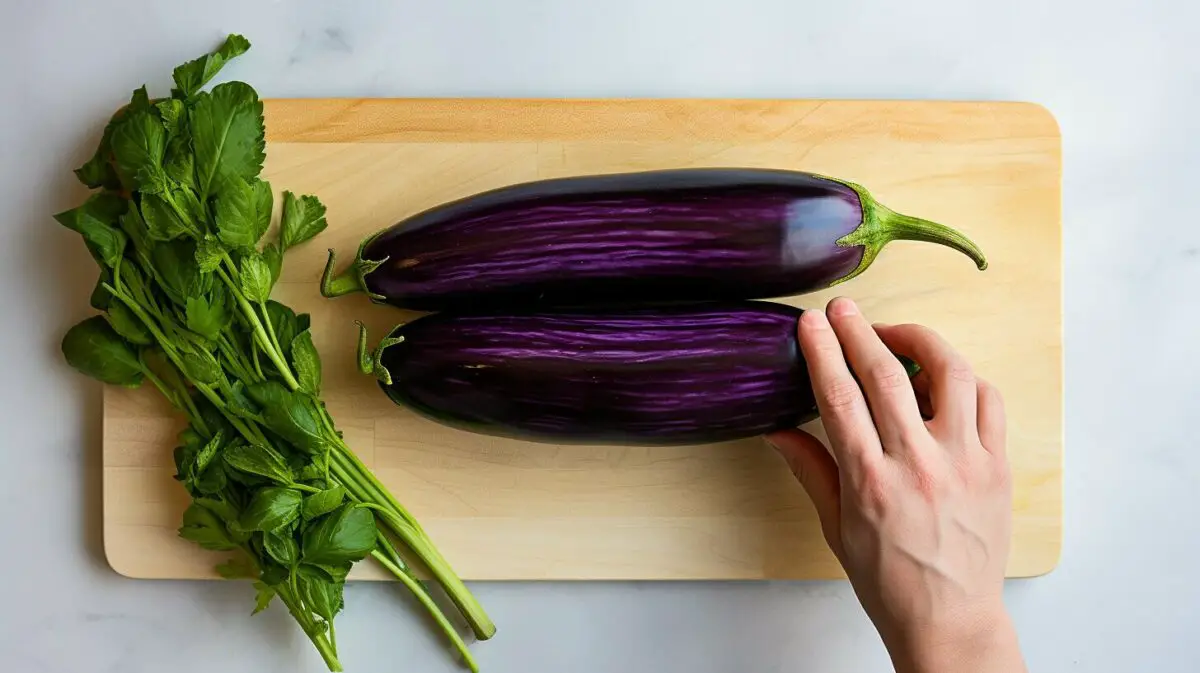
Slicing the Eggplant into Cubes
Cubed eggplant is versatile and works well in a variety of dishes. Here’s how you can easily slice your eggplant into perfect cubes.
- Start by laying the eggplant on its side and slicing it lengthwise into long, flat pieces. Aim for a thickness of about 1 inch.
- Next, lay each flat piece down and slice lengthwise again to create long, thin strips.
- Finally, slice the strips horizontally to make small cubes. The size of the cubes can vary depending on your preference and the recipe you’re following.
By following these steps, you’ll have beautifully sliced eggplant cubes ready to be incorporated into your favorite recipes.
Why Cubed Eggplant?
Cubed eggplant offers a variety of cooking options. Its small size allows for quicker and more even cooking, making it ideal for stir-fries, curries, stews, and roasted vegetable medleys.
The consistent shape of the cubes also lends itself well to dishes where uniformity is desired, such as skewers, kebabs, and pasta salads. The cubes can easily absorb flavors from marinades, sauces, and spices, creating a delicious and satisfying taste experience.
| Benefits of Cubed Eggplant | Disadvantages of Cubed Eggplant |
|---|---|
|
|
“Cubed eggplant adds a delightful texture and taste to dishes. The small, bite-sized pieces soak up flavors and cook evenly, making them a great addition to a variety of recipes.” – Chef Jessica Smith
Next time you’re preparing a dish that calls for eggplant, consider using cubed eggplant for a convenient and delicious cooking experience. Its versatility and ability to absorb flavors will surely elevate your culinary creations.
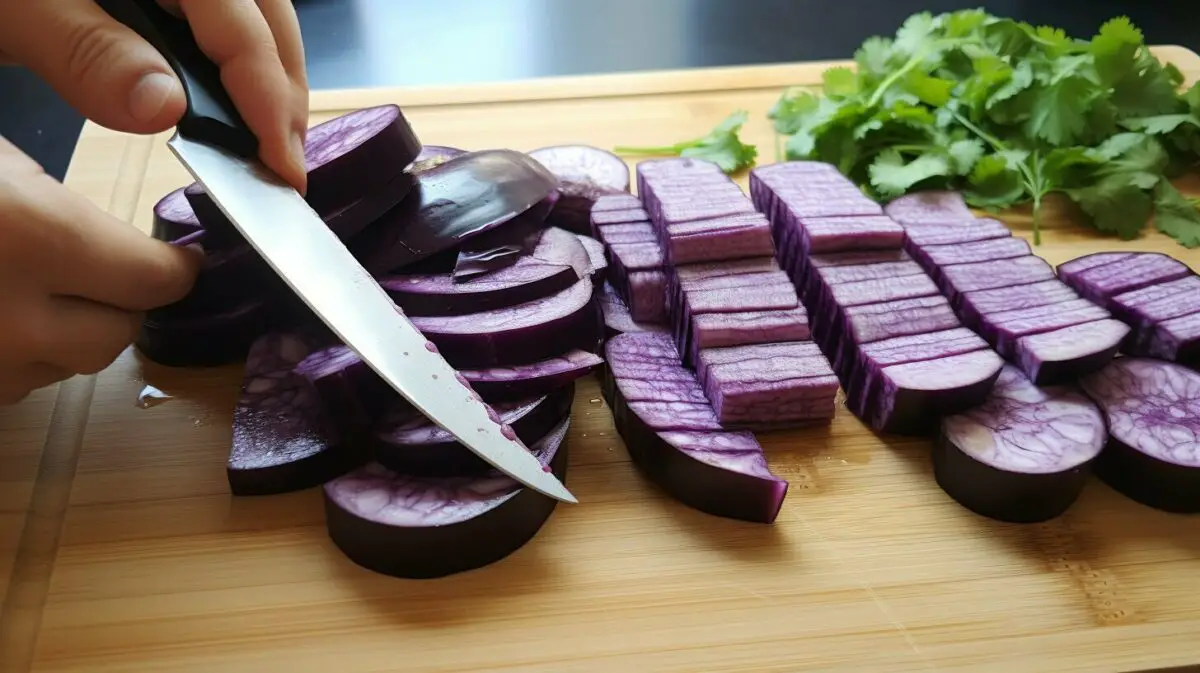
When it comes to the skin and seeds of an eggplant, there are a few factors to consider. Let’s explore whether you should keep or remove them.
The skin of an eggplant is totally edible and can add texture to your dishes. However, some recipes may call for peeled eggplant. If you decide to remove the skin, simply use a peeler or a knife to gently peel the eggplant before cutting it. Just keep in mind that the skin contains valuable nutrients, so if the recipe permits, leaving it on can enhance both the taste and nutritional value of your dish.
As for the seeds, they are safe to eat, but they can have a bitter taste. If you prefer a milder flavor, you may want to remove them. To do so, simply cut the eggplant in half lengthwise and use a spoon to scoop out the seeds. This way, you can enjoy the smooth, fleshier part of the eggplant without the bitterness.
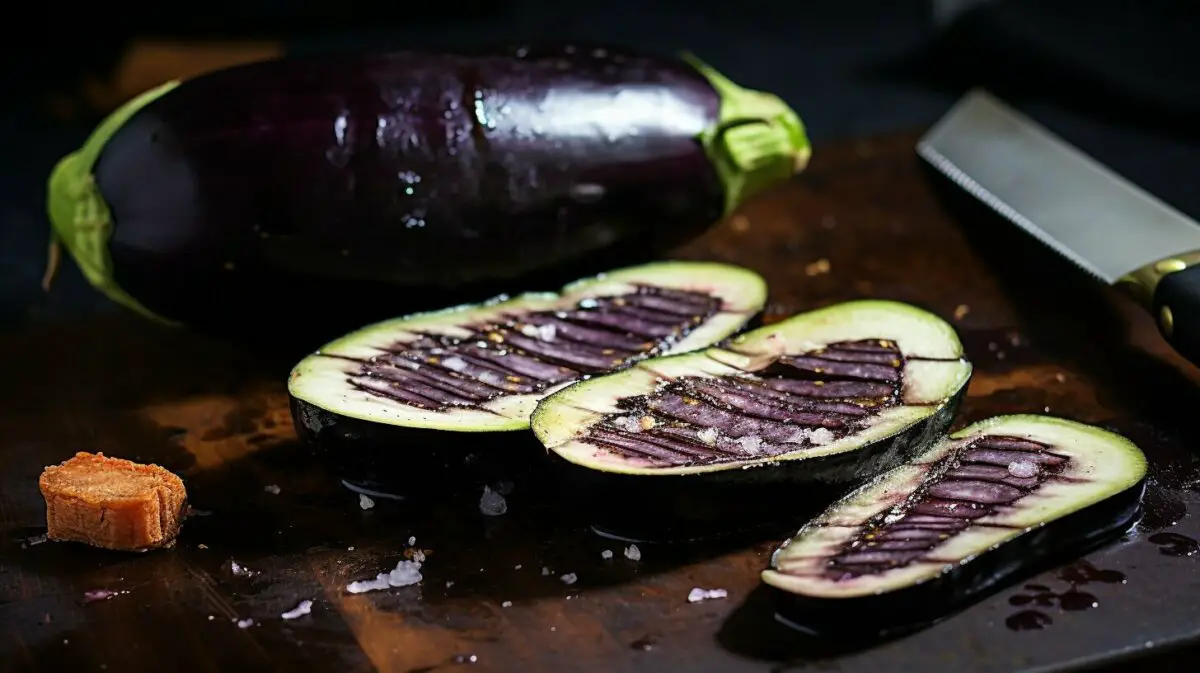
It’s worth noting that while some people choose to remove both the skin and seeds, others love the taste and texture they provide. Ultimately, it’s a matter of personal preference and the specific recipe you’re following. So don’t be afraid to experiment and find what works best for you!
Cooking and Caring for Cut Eggplant
Once you have cut your eggplant, it’s time to cook it to bring out its delicious flavors. Discover some essential cooking tips and how to properly store cut eggplant.
First, if you want to reduce any bitterness in the eggplant, lightly salt the sliced pieces and let them sit for about 30 minutes before cooking. This step helps to draw out any excess moisture and can enhance the overall flavor.
When it comes to cooking eggplant, using enough oil is key. Eggplant is known for absorbing oil quickly, so be generous when oiling the pan. This will not only prevent sticking but also give the eggplant a beautiful caramelization. Just be sure to avoid overcrowding the pan to ensure each piece cooks evenly.
To store cut eggplant, place it in an airtight container and keep it in the refrigerator. This will help keep it fresh for up to a week. If you have excess cut eggplant that you don’t plan to use immediately, you can also freeze it. To do so, blanch the raw cut eggplant in boiling water for a couple of minutes, then cool and drain it before placing it in a freezer-safe container or bag. Frozen cut eggplant can last for up to 6 months in the freezer.
Remember, when it comes to eggplant, cooking it brings out its best flavors. So, whether you’re making a delicious eggplant parmesan, baba ganoush, or grilled eggplant, follow these cooking tips to achieve mouthwatering results. Enjoy!
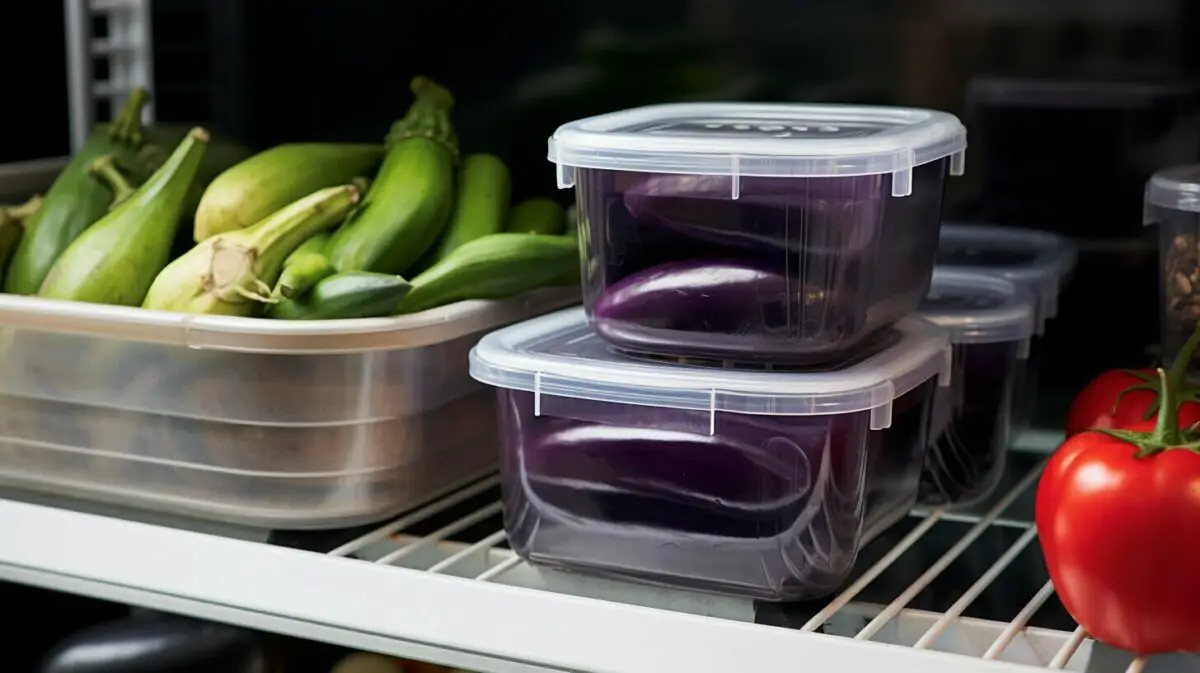
If you find yourself with an abundance of cut eggplant, freezing it is a great way to preserve its freshness. Learn how to freeze and thaw cut eggplant with these simple steps.
Blanching:
Before freezing eggplant, it’s recommended to blanch it first. Blanching helps preserve the color, flavor, and texture of the eggplant. Here’s how to blanch cut eggplant:
- Bring a large pot of water to a boil.
- Prepare a bowl of ice water.
- Add the cut eggplant to the boiling water and blanch for 4-5 minutes.
- Using a slotted spoon, transfer the eggplant to the ice water to stop the cooking process.
- Once cooled, drain the eggplant and pat it dry.
Freezing:
After blanching the eggplant, it’s time to freeze it for long-term storage. Follow these steps to freeze cut eggplant:
- Arrange the blanched and dried eggplant in a single layer on a baking sheet lined with parchment paper.
- Place the baking sheet in the freezer and let the eggplant freeze for a few hours or until firm.
- Once the eggplant is frozen, transfer it to airtight freezer bags or containers. Label the bags or containers with the date.
- Remove any excess air from the bags or containers and seal them tightly.
Thawing:
When you’re ready to use the frozen eggplant, it’s important to thaw it properly to preserve its texture. Follow these steps to thaw cut eggplant:
- Remove the frozen eggplant from the freezer and place it in the refrigerator overnight to thaw slowly.
- Once thawed, the eggplant may release some liquid. Gently pat it dry with paper towels before using it in your recipes.
By blanching and freezing cut eggplant, you can enjoy its freshness even when it’s out of season. Whether you plan to use it in stews, stir-fries, or casseroles, frozen eggplant can be a convenient ingredient that saves both time and money.
| Blanching | Freezing | Thawing |
|---|---|---|
| Boil water | Arrange on a baking sheet | Thaw in the refrigerator |
| Add eggplant | Freeze on the baking sheet | Pat dry |
| Transfer to ice water | Transfer to freezer bags/containers | |
| Drain and dry | Remove excess air and seal |
Now that you know how to freeze and thaw cut eggplant, you can enjoy this versatile vegetable all year round. Try adding it to soups, stews, or even making a delicious eggplant Parmesan. With the right techniques, your frozen eggplant will retain its flavor and texture, allowing you to enjoy the taste of summer anytime.

Now that you’re an expert at cutting eggplant, it’s time to put your culinary skills to use with these delicious and popular eggplant recipes. From hearty Italian classics to flavorful Middle Eastern dips, there’s something for everyone to enjoy. So grab your freshly cut eggplant and let’s get cooking!
Eggplant Parmesan
This classic Italian dish is a favorite for many, and for good reason. Layered with breaded and fried eggplant slices, marinara sauce, and gooey melted cheese, Eggplant Parmesan is a comforting and satisfying meal. Serve it with a side of pasta or a fresh green salad for a complete dinner.

Hailing from the Middle East, Baba Ganoush is a delicious roasted eggplant dip that is perfect for snacking or as a party appetizer. Made with charred eggplant, tahini, garlic, lemon juice, and olive oil, this creamy dip is best enjoyed with warm pita bread or fresh vegetables.
Grilled Eggplant
For a lighter and healthier option, grilled eggplant is a fantastic choice. Simply brush the eggplant slices with olive oil, sprinkle them with salt and pepper, and grill them until tender and slightly charred. Grilled eggplant can be served as a side dish, added to salads, or used as a topping for sandwiches and burgers.
Now that you have these mouthwatering eggplant recipes at your fingertips, it’s time to get creative in the kitchen. Experiment with different flavors, spices, and cooking techniques to make these dishes your own. Whether you’re a seasoned chef or a beginner cook, these recipes are sure to impress and satisfy your taste buds. Enjoy!
Conclusion – How to Cut Eggplant
Cutting eggplant doesn’t have to be intimidating. With the right techniques and tools, you can confidently prepare this versatile vegetable for all your favorite dishes.
To start, make sure you select the right eggplant for your recipe and gather a large chef’s knife and cutting board. Washing and drying the eggplant is essential before removing the ends by slicing them off at the stem and bottom.
Once you have prepared the eggplant, you can slice it into rounds, long strips, or cubes, depending on your desired outcome. For rounds, simply lay the eggplant on its side and slice crosswise into 1-inch-thick rounds. For long, flat pieces, lay the eggplant on its side and slice lengthwise into 1-inch-thick ovals, perfect for layering in casseroles. And for cubes, slice the eggplant lengthwise, lay the flat pieces down, and slice lengthwise again to create long, thin strips. Finally, slice the strips horizontally to make small cubes.
When it comes to the skin and seeds of the eggplant, it’s important to note that the skin is edible and can add texture to dishes. However, some recipes may call for peeled eggplant. The seeds are safe to eat but can have a bitter taste. If desired, you can remove them by scooping them out with a spoon.
Lastly, remember to cook the eggplant before consuming it, as the FDA recommends against eating it raw. To reduce bitterness and enhance flavors, you can lightly salt the sliced eggplant and let it sit for 30 minutes before cooking. When cooking, be generous with the oil as eggplant absorbs fat quickly and avoid overcrowding the pan to achieve perfect caramelization on each piece. And if you have leftover cut eggplant, store it in an airtight container in the fridge for up to a week or blanch it before freezing for up to 6 months.
By following these steps and tips, you can confidently cut and prepare eggplant for a variety of delicious recipes. So go ahead and explore the culinary possibilities with this delightful vegetable!
FAQ – How to Cut Eggplant:
Q: How do I select the right eggplant for my recipe?
A: When selecting eggplant, choose ones that have smooth, shiny skin without any blemishes or bruises. They should feel heavy for their size, indicating that they are fresh and full of moisture.
Q: What tools do I need to cut eggplant?
A: To cut eggplant, you will need a large chef’s knife and a cutting board. These tools will help you slice the eggplant with ease and precision.
Q: Should I remove the skin from the eggplant?
A: Whether or not you remove the skin from the eggplant depends on the recipe. The skin is edible and can add texture to dishes, but some recipes call for peeled eggplant.
Q: Can I eat the eggplant seeds?
A: Eggplant seeds are safe to eat, but they can have a bitter taste. You can remove them if desired by scooping them out with a spoon.
Q: Do I need to cook eggplant before eating it?
A: Yes, it’s important to cook eggplant before consuming it, as the FDA does not recommend eating it raw. Cooking not only enhances the flavors but also reduces bitterness.
Q: How should I store cut eggplant?
A: Store cut eggplant in an airtight container in the fridge for up to a week. This will help preserve its freshness and prevent it from spoiling.
Q: Can I freeze cut eggplant?
A: Yes, you can freeze cut eggplant. Before freezing it, blanch the raw cut eggplant by briefly boiling it in water. This will help preserve its quality. Frozen cut eggplant can be stored for up to 6 months in the freezer.
Our Friends:
- https://feelgoodfoodie.net/recipe/how-to-cut-eggplant/
- https://www.thekitchn.com/how-to-cut-eggplant-23570914
- https://foolproofliving.com/how-to-cut-eggplant/
Related Recipes:
 How to Cut Eggplant: Tips for Perfect Dishes
How to Cut Eggplant: Tips for Perfect Dishes
 How to Tell if Eggplant is Bad: Visual Guide
How to Tell if Eggplant is Bad: Visual Guide
 How to Cut a Watermelon? (Perfect Step-By-Step Guide)
How to Cut a Watermelon? (Perfect Step-By-Step Guide)
 Cleaning Plastic Cutting Boards: Tips and Tricks
Cleaning Plastic Cutting Boards: Tips and Tricks
 How to Cut a Tomato? (Perfect Step-By-Step Guide)
How to Cut a Tomato? (Perfect Step-By-Step Guide)
 How to Cut Up a Chicken Breast for Recipes
How to Cut Up a Chicken Breast for Recipes
 How to Cut Dragon Fruit? (Perfect Step-By-Step Guide)
How to Cut Dragon Fruit? (Perfect Step-By-Step Guide)
 How to Cut a Tomato: Techniques for Every Dish
How to Cut a Tomato: Techniques for Every Dish








